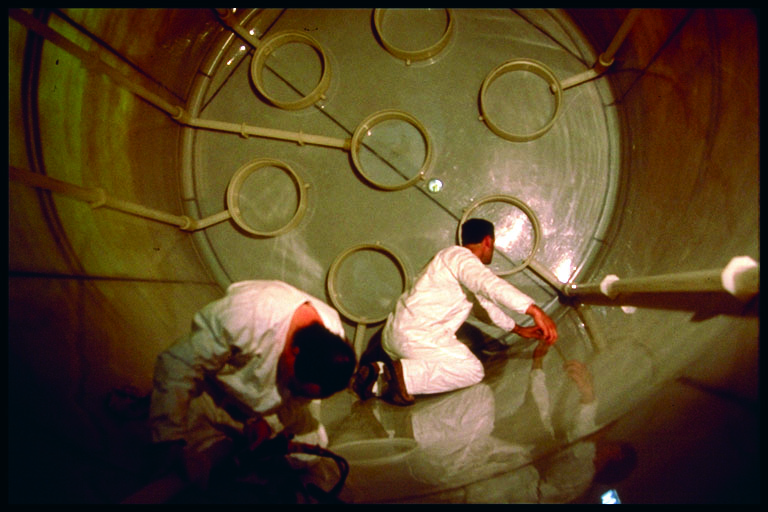Advances in the Use of AWS Standards in the Chemical Industry

A first-hand account of thermoplastic practices
Reprinted with permission: The AWS Welding Journal
I have worked in the thermoplastic industry for a number of years. During that time, I have observed that the major reasons for using thermoplastics are corrosion resistance and high purity. Thermoplastic lined metal vessels, along with fiber-reinforced plastic thermoplastic lined vessels, and thermoplastic structural components are commonly used— Fig. 1.
The main reasons for not utilizing thermoplastics are as follows:
- Lack of knowledge about the materials
- Failure incidences
- Previous negative experiences
In this article, I detail all three of these issues, including a focus on American Welding Society (AWS) Standards.
Lack of Knowledge
There is a large amount of technical knowledge and many case histories, testing reports, and reputable consultants available. While accessing these resources may require some costs, they could ultimately result in savings.
Some additional sources for information and assistance are as follows:
- Attending trade shows and supplier seminars
- Looking at case histories by manufacturers and other resources from technical societies, such as AWS, the American Society of Mechanical Engineers (ASME), and the Dual Laminate Fabrication Association
- Browsing fabricators’ web pages.
Lack of knowledge is no longer a valid excuse, in my opinion.
Failure Incidences
I have seen failures in both metallics and polymers. A common failure in material begins with the failure to properly select and engineer the design. This is equally true of polymer and metals.
Previous Negative Experiences
Here are some questions I’ve heard: Why isn’t a thermoplastic welder adhering to the AWS B2.4, Specification for Welding Procedure and Performance Qualification for Thermoplastics, Standard required or considered for vessels and liners? Why isn’t a thermoplastic welding inspector adhering to the utilized AWS G1.6, Specification for the Qualification of Plastics Welding Inspectors for Hot Gas, Hot Gas Extrusion, and Heated Tool Butt Thermoplastic Welds? If the material were metallic, a certified AWS welder and inspector would be required.
Failure to apply existing standards for the fabrication and welding of a thermoplastic vessel or liner that holds dangerous, corrosive, or other hazardous materials should be sufficient reasons to require a proficient welder. An excuse given could be that the supplied fabricator claimed his or her work was the best in the world. If it fails, the fabricator will claim it isn’t his or her fault, stating it is the plastic. Do you believe that? I say it is the end user’s fault for not requiring existing AWS certified welders and other thermoplastic standards that are readily available.
Materials have changed to make the thermoplastics more durable. Welds can be controlled, welding procedure specifications (WPSs) examples are available, and welder qualification exists.
AWS standards are not new. Here’s a brief history lesson from my memory: The thermoplastic welder qualification standard, B2.4, began in March 1994. Later on, in November 1998, John Gayler, serving as secretary to the G1A Subcommittee on Hot Gas Welding and Extrusion Welding, helped move this standard forward using existing metal formats as a guide. G1A later changed to the B2 format when the United Association became involved in writing the standard. The efforts of many have produced thermoplastic standards for welders and welding procedures, the qualifications for thermoplastic welding inspectors, and a standard for visual evaluation of thermoplastic welds (available for purchase at pubs.aws.org).
These standards are cited in ASME specifications, government requirements, and company specifications. Prior to this, a WPS for a thermoplastic weld was seldom used. Now, a WPS should be commonplace.
If due diligence, common sense, and education prior to fabrication are utilized, thermoplastics can be cost effective and long lasting.
Descriptive diagrams of thermoplastic welds are available in AWS G1.10M:2016, Guide for the Evaluation of Thermoplastic Welds, illustrating acceptable and non-acceptable welds.
A one-day class pertaining to AWS G1.10 training is extremely helpful to educate company inspectors as well as maintenance and management personnel.
Even as you review this article, organizations like Bryan Hauger Consulting Inc., a plastics consulting firm in Boulder, Colo., are working with individuals like Bob Stakenborghs, CEO at Advanced Clean Energy Consulting, Baton Rouge, La., on enhancing the capabilities of full-calibrated metrology-grade microwave instruments for the inspection of high-density polyethylene butt joint welds. This method of inspection has been in use for some time. For reference, view ASTM International E3101, Standard Practice for Microwave Examination of Polyethylene Butt Fusion Joints, and E3102, Standard Practice for Microwave Examination of Polyethylene Electrofusion Joints Used in Piping Application, as well as ASME Boiler and Pressure Vessel Code, Section III, Appendix XXVI. There are also similar activities by The Welding Institute, Cambridge, UK, introducing nondestructive examination methods.
Conclusion
The availability of AWS and other standards to control and evaluate thermoplastic welds has greatly improved during the 55 years that I have been associated with thermoplastics. The proper use of thermoplastics, available standards, and engineering practices can save companies money. Improving the quality and reliability of thermoplastic vessels, linings, pipelines, and similar applications is an AWS goal.
Acknowledgments
The author would like to thank Shirleen Chandler at Engiplast Inc., Gatesville, Tex., as well as Bryan Hauger and Bob Stakenborghs at Bryan Hauger Consulting Inc., Boulder, Colo., for their contributions to this article.















